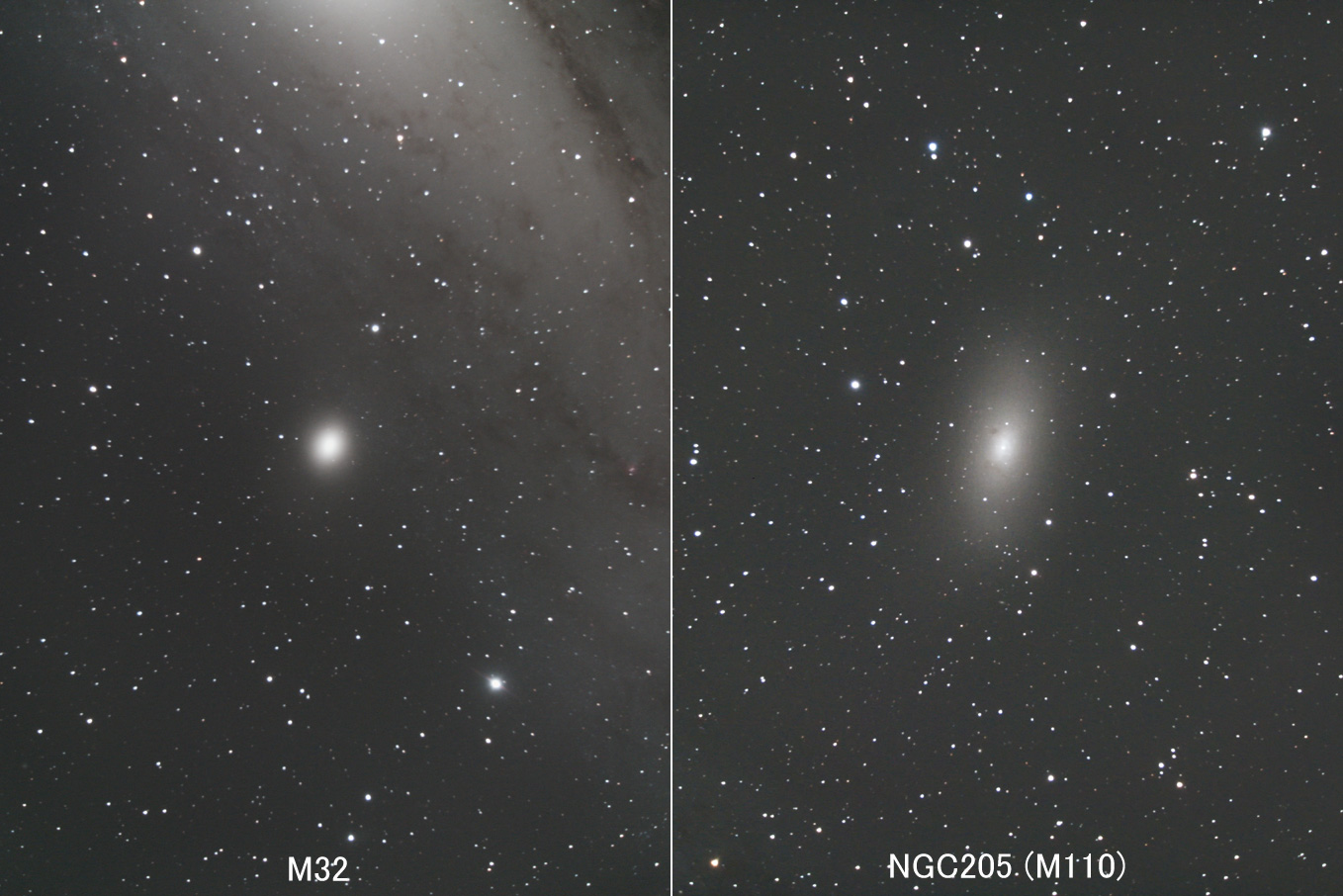Deep Sky Object in Autumn
M31 (The Andromeda Galaxy)
Click on image to enlarge
| Date & Time: | Dec 24 2022, from 19:37 to 21:07 JST(+0900) |
| Mosaic of 2 flames of 8min.×6shots |
| Optical: | TAKAHASHI 16cm(6.3") epsilon (f=530mm, F3.3) |
| with IDAS LPS-D1 Light-pollution suppression filter |
| Auto-guided with TAKAHASHI JP Equatorial+SBIG STV |
| CMOS Camera: | ZWO ASI2600MC Pro (Cooled temp.: -25°C) |
| Location: | Ooizumi, Hokuto city, Yamanashi pref. |
| Camera Settings: | Recording format...16bit FITS, converted to 16bit TIFF(6248×4176) |
| Device Size...23.5×15.7mm, Gain...100 |
| M31 (NGC224) / Galaxy, type SA(s)b I-II |
|---|
| R.A. | 00h 42m 44.3s (2000.0) |
|---|
| Dec. | +41° 16' 08" (2000.0) |
|---|
| Apparent Size | 190.5×61.7' |
|---|
| Radial Velocity | -121km/s |
|---|
| Magnitude | 4.8 |
|---|
| Distance | 2.3 million light yrs. |
|---|
| Group of Galaxies | Local Group of Galaxies |
|---|
| Other IDs | UGC454, MCG7-2-16,
PGC02557 |
|---|
I think you know at least the name of this Galaxy even if you don't gaze at stars habitually,
it's a Messier's object representative of the night sky in autumn.
M31 is only one celestial body recognized as a non-stellar object before the telescope was invented.
M31 has a size of 190'×60', it's larger than six times of apparent diameter of the Moon.
The galaxy lies at about fifteen-degrees angle from being edge-on, and it has a bright oval nucleus, a dust lane become visible in medium-sized telescopes.
Its distance is approximately 2.3 millions light years.
|
Click on image to enlarge
Close-up of companeon galaxies M32 & NGC205
| Date & Time: | M32: Dec 24 2022, from 19:53 to 20:47 JST(+0900), 6min.×10shots |
| NGC205: Dec 24 2022, from 18:48 to 19:42 JST(+0900), 6min.×10shots |
| Optical: | Meade 25cm(10") Schmidt-Cassegrain with conversion lens (f=1600mm, F6.3) |
| with IDAS LPS-P1 Light-pollution suppression filter |
| Auto-guided with Meade LX200 Equatorial & Lacerta M-GEN |
| Digital Camera: | Nikon D810A |
| Location: | Ooizumi, Hokuto city, Yamanashi pref. |
| Camera Settings: | Recording Format...14bit CCD-RAW, converted to 16bit TIFF(4080×4080) |
| Device Size...20×20mm |
| Sensitivity...ISO4000, White Balance...Daylight |
| M32 (NGC221) / Galaxy, type cE2 |
|---|
| R.A. | 00h 42m 41.8s (2000.0) |
|---|
| Dec. | +40° 51' 55" (2000.0) |
|---|
| Apparent Size | 8.8×6.5' |
|---|
| Radial Velocity | -28km/s |
|---|
| Magnitude | 9.1 |
|---|
| Distance | 2.9 million light yrs. |
|---|
| Group of Galaxies | Local Group of Galaxies |
|---|
| Other IDs | UGC452, MCG7-2-15
PGC02555 |
|---|
|
| NGC205 (M110) / Galaxy, type E5 pec |
|---|
| R.A. | 00h 40m 22.5s (2000.0) |
|---|
| Dec. | +41° 41' 11" (2000.0) |
|---|
| Apparent Size | 21.9×10.8' |
|---|
| Radial Velocity | -60km/s |
|---|
| Magnitude | 8.9 |
|---|
| Distance | 2.9 million light yrs. |
|---|
| Group of Galaxies | Local Group of Galaxies |
|---|
| Other IDs | UGC426, MCG7-2-14
PGC02429 |
|---|
|
This is a close-up image of two bright companion galaxies of M31.
M32 is a round-shaped dwarf elliptical galaxy with an apparent diameter of less than 10 arc minutes, which can be seen 30 arc minutes south of the center of M31.
It is thought that most of the interstellar gas in M32 was sucked out during the approach with M31, and currently little star formation occurred.
NGC205 is an elliptical galaxy located about 40 minutes northwest of the central nucleus of M31.
Also known as the last number 110 in the Messier's Catalog, this is an unofficial number.
Although it is paler than M32, it has a major axis of over 20 arc minutes. In this image, indistinct dark bands are recognized inside.
|


